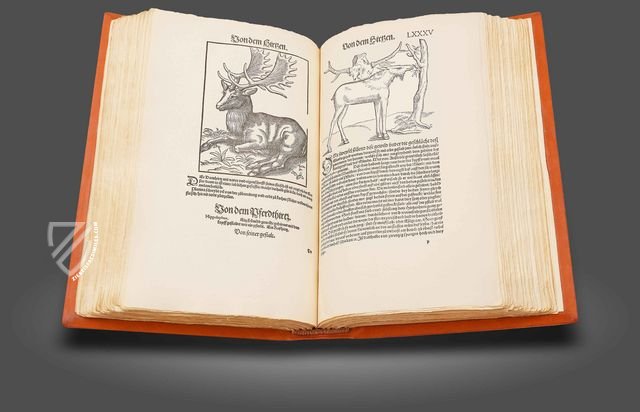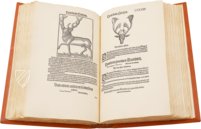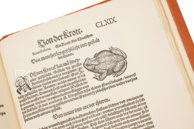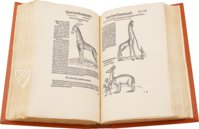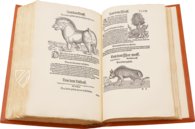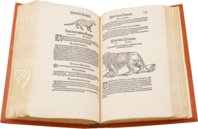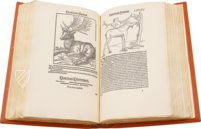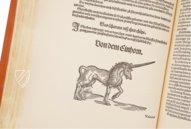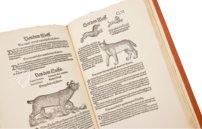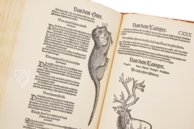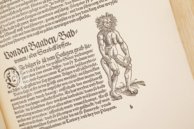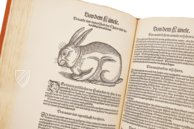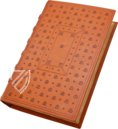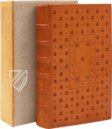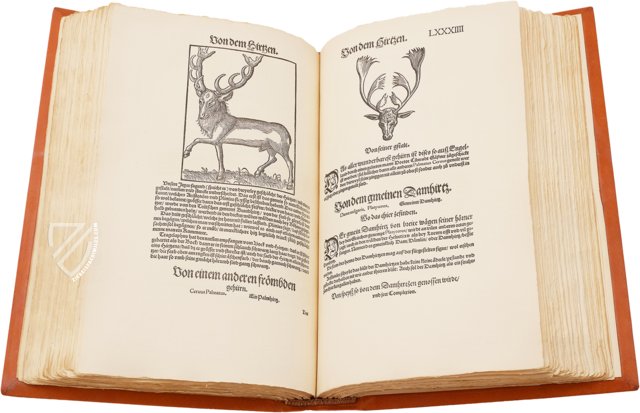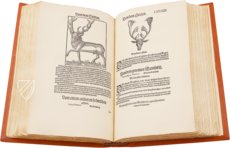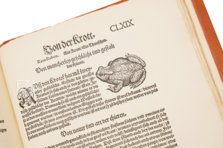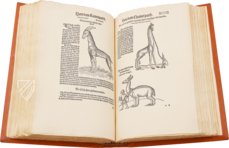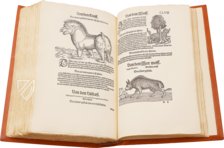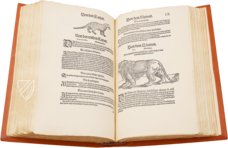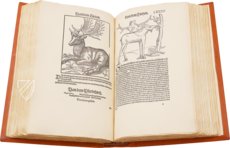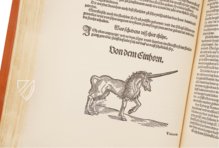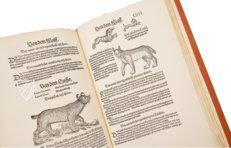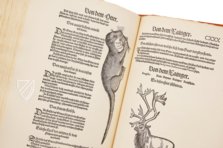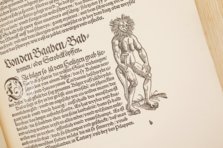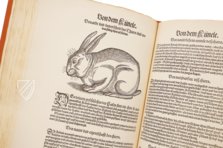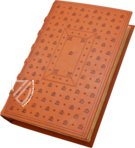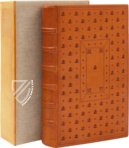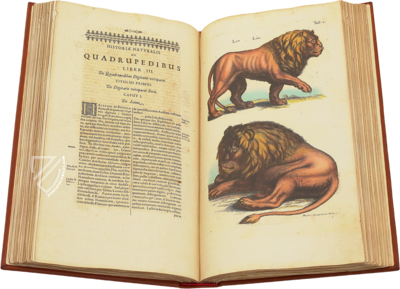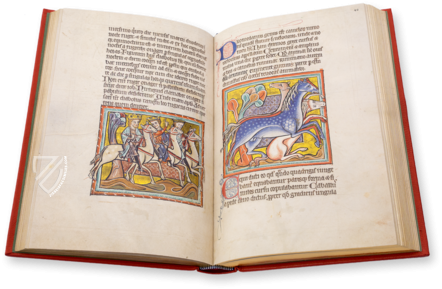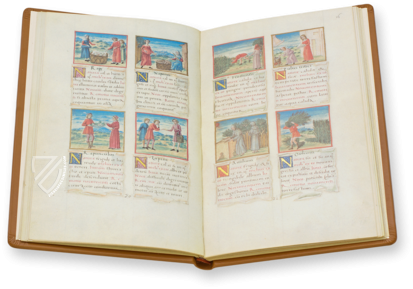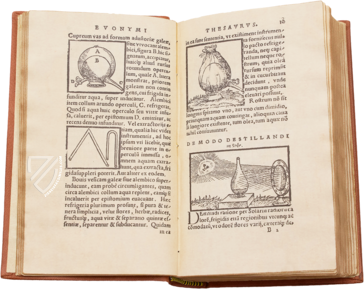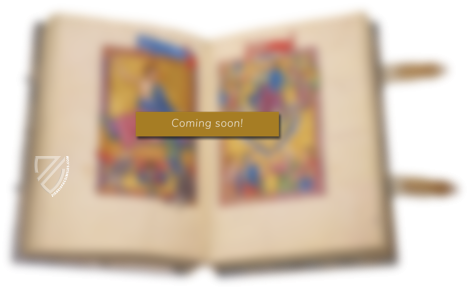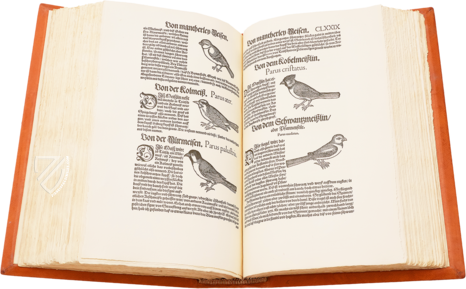Conrad Gessner: Thierbuch
(3,000€ - 7,000€)
The Thierbuch ( i.e. 'Animal Book') is the first volume of the influential opus magnum of the physician, naturalist and philologist Conrad Gessner (1516–1565): the Historia animalium. In this four-volume Latin compendium, published between 1551 and 1558, the humanist scholar brought together the entire zoological knowledge of his time, aided by his extensive contacts with many other European scholars. For both the text and the remarkable illustrations, he drew on existing works, such as Albrecht Dürer's Rhinoceros, which is why quite a few mythical creatures appear in the encyclopedia. At the same time, however, it also contains scientific observations and impressively realistic woodcuts, with which Gessner laid a foundation for modern zoology. The first German edition of the Thierbuch was translated by Conrad Forer and published by Christoph Froschauer in Zurich in 1563. In it, all then known viviparous quadrupedal animals are comprehensively described in alphabetical order and illustrated by 145 elaborate and often full-page woodcuts.
Conrad Gessner: Thierbuch
Conrad Gessner (1516–1565) was a Zurich physician, naturalist and philologist. After studying in Bourges and Paris, he worked as a teacher, professor of Greek language and natural history as well as a physician and continually supplemented his livelihood through scholarly writing. What began pragmatically soon became his passion: Until the end of his life, he pursued studies in natural history and even published a geological treatise in the year of his death – he died of the plague in 1565.
Gessner's Magnum Opus
With the Historia animalium, which was intended to bring together all the zoological knowledge of his time, Gessner not only created his personal magnum opus, but also became the founder of modern zoology, as he gave greater weight to his own observations of nature than to the traditional knowledge of antiquity and the Middle Ages in the four-volume work. However, these still form the basis of the Latin compendium. It is also a reflection of his philological interest: Gessner attached great importance to listing the individual names of the animal species in different languages and mentioning all vernacular variations of their names.
Historia Animalium
Gessner initially published the four extensive volumes on live-bearing quadrupeds (Quadrupedes vivipares), egg-laying quadrupeds (Quadrupedes ovipares), birds (Avium natura) and aquatic creatures (Piscium & aquatilium animantium natura) in Latin. They were published between 1551 and 1558 by Christoph Froschauer in Zurich. In 1587, a further posthumous publication of a fifth volume on snakes was released, which appeared in his estate.
Science and Fantasy
Even the first editions were illustrated with hundreds of woodcuts, which form an important part of the work. While he drew on existing works for most of the illustrations, such as the famous Rhinoceros by Albrecht Dürer or the giraffe from Bernhard von Breydenbach'sPeregrinatio in terram sanctam, he also made some woodcuts himself – 65 in number. Many of the illustrations are purely works of fantasy or were made on the vague basis of verbal descriptions. However, there are also some based on precise observations of nature, which was still an absolute novelty in the 16th century.
The Thierbuch
The entire work quickly became a zoological bestseller, which brought Gessner international fame. Thus Conrad Forer translated the first volume of the series into German a good 10 years after its publication. The translation was first published in 1563, also by Christoph Froschauer in Zurich. Here too, the texts, which comprehensively describe all then known live-bearing quadrupeds in alphabetical order, are supplemented by exquisite woodcuts, some of which are astonishingly naturalistic and come in various sizes.
Codicology
- Alternative Titles
- Thierbuch von Conrad Gessner
Thierbuoch: das ist ein kurtze Bschreybung aller vierfüssigen Thieren, so auff der Erden und in Wassern wonend, sampt jrer waren Conterfactur
Thierbuch. Faksimile nach der Ausgabe bei Froschauer, Zürich 1563.
Historia animalium
Quadrupedes vivipares et ovipares - Size / Format
- 176 pages / 39.0 × 25.0 cm
- Origin
- Switzerland
- Date
- 1563
- Epochs
- Style
- Language
- Illustrations
- 145 woodcuts, many of them full-page, + 1 title page
- Content
- Descriptions of 155 quadrupedal, viviparous animal species
- Artist / School
- Conrad Gessner (author)
Conrad Forer (translator)
Christoph Froschauer (printer/publisher)
Conrad Gessner: Thierbuch
Chameleon
Quite different from the wild, this chameleon immediately catches the eye. The large-format woodcut shows an astonishingly adequate version of a chameleon, although the actual species cannot be precisely determined on either a textual or pictorial level. The animal, whose appearance is described as a cross between a crocodile and a rat, clings with its four feet to a vertically arranged branch and appears extremely stiff, not least because of its peculiar set of teeth and its rigidly upturned, wide-open eyes.
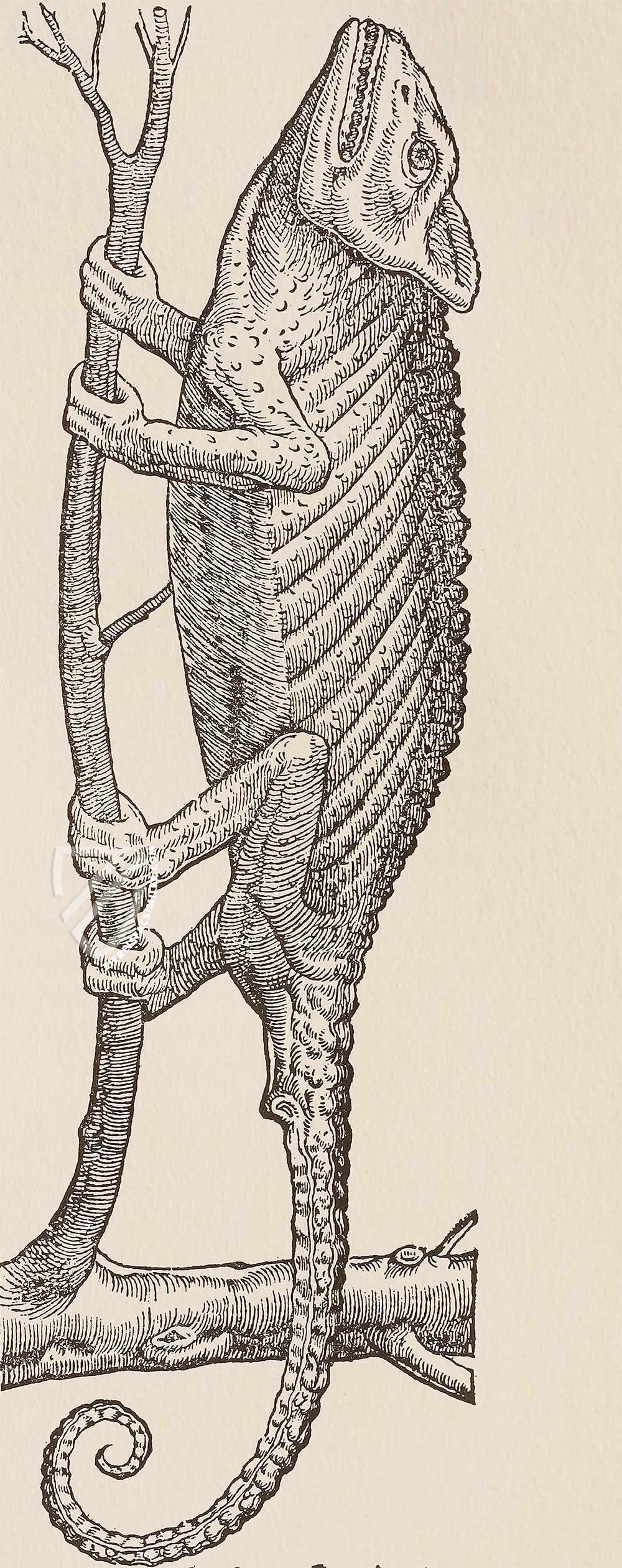
Conrad Gessner: Thierbuch
Dürer's Rhinoceros
For his paragraph on the rhinoceros, Gessner made use of one of the most famous animal depictions of modern times: Albrecht Dürer's Rhinoceros. The Renaissance artist created the breathtakingly detailed and fine woodcut in 1515 based on a description – as he himself had never seen it. At the time, the animal had come to Portugal as a gift from an Indian prince to the royal court. As the first specimen of its kind on the European continent since antiquity, it aroused great wonder and admiration.
In a fantastical manner, Dürer presents the viewer with a severe side view of the massive animal: the body is protected by ornamental armor-like plates, while the legs are covered with scaly skin. The impressive horn on the nose, however, has a questionable structure, and the second, smaller horn has shifted to the back, strongly reminiscent of depictions of unicorns. As in Gessner's corresponding text, reality is mixed with hearsay also on the pictorial level, as was common in medieval and early modern natural history.
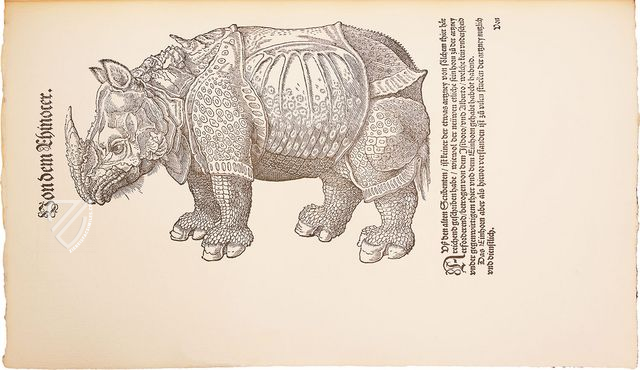
#1 Thierbuch. Faksimile nach der Ausgabe bei Froschauer, Zürich 1563.
Language: German
The commentary volume includes a synoptic index of Gessner's Latin and German animal names and their modern scientific synonyms.
(3,000€ - 7,000€)
#2 Thierbuch. Faksimile nach der Ausgabe bei Froschauer, Zürich 1563. (Standard Edition)
(1,000€ - 3,000€)
- Treatises / Secular Books
- Apocalypses / Beatus
- Astronomy / Astrology
- Bestiaries
- Bibles / Gospels
- Chronicles / History / Law
- Geography / Maps
- Saints' Lives
- Islam / Oriental
- Judaism / Hebrew
- Single Leaf Collections
- Leonardo da Vinci
- Literature / Poetry
- Liturgical Manuscripts
- Medicine / Botany / Alchemy
- Music
- Mythology / Prophecies
- Psalters
- Other Religious Books
- Games / Hunting
- Private Devotion Books
- Other Genres
- Afghanistan
- Armenia
- Austria
- Belgium
- Belize
- Bosnia and Herzegovina
- China
- Colombia
- Costa Rica
- Croatia
- Cyprus
- Czech Republic
- Denmark
- Egypt
- El Salvador
- Ethiopia
- France
- Germany
- Greece
- Guatemala
- Honduras
- Hungary
- India
- Iran
- Iraq
- Israel
- Italy
- Japan
- Jordan
- Kazakhstan
- Kyrgyzstan
- Lebanon
- Liechtenstein
- Luxembourg
- Mexico
- Morocco
- Netherlands
- Palestine
- Panama
- Peru
- Poland
- Portugal
- Romania
- Russia
- Serbia
- Spain
- Sri Lanka
- Sweden
- Switzerland
- Syria
- Tajikistan
- Turkey
- Turkmenistan
- Ukraine
- United Kingdom
- United States
- Uzbekistan
- Vatican City
- A. Oosthoek, van Holkema & Warendorf
- Aboca Museum
- Ajuntament de Valencia
- Akademie Verlag
- Akademische Druck- u. Verlagsanstalt (ADEVA)
- Aldo Ausilio Editore - Bottega d’Erasmo
- Alecto Historical Editions
- Alkuin Verlag
- Almqvist & Wiksell
- Amilcare Pizzi
- Andreas & Andreas Verlagsbuchhandlung
- Archa 90
- Archiv Verlag
- Archivi Edizioni
- Arnold Verlag
- ARS
- Ars Magna
- ArtCodex
- AyN Ediciones
- Azimuth Editions
- Badenia Verlag
- Bärenreiter-Verlag
- Belser Verlag
- Belser Verlag / WK Wertkontor
- Benziger Verlag
- Bernardinum Wydawnictwo
- BiblioGemma
- Biblioteca Apostolica Vaticana (Vaticanstadt, Vaticanstadt)
- Bibliotheca Palatina Faksimile Verlag
- Bibliotheca Rara
- Boydell & Brewer
- Bramante Edizioni
- Bredius Genootschap
- Brepols Publishers
- British Library
- C. Weckesser
- Caixa Catalunya
- Canesi
- CAPSA, Ars Scriptoria
- Caratzas Brothers, Publishers
- Carus Verlag
- Casamassima Libri
- Centrum Cartographie Verlag GmbH
- Chavane Verlag
- Christian Brandstätter Verlag
- Circulo Cientifico
- Club Bibliófilo Versol
- Club du Livre
- CM Editores
- Collegium Graphicum
- Collezione Apocrifa Da Vinci
- Comissão Nacional para as Comemorações dos Descobrimentos Portugueses
- Coron Verlag
- Corvina
- CTHS
- D. S. Brewer
- Damon
- De Agostini/UTET
- De Nederlandsche Boekhandel
- De Schutter
- Deuschle & Stemmle
- Deutscher Verlag für Kunstwissenschaft
- DIAMM
- Droz
- E. Schreiber Graphische Kunstanstalten
- Ediciones Boreal
- Ediciones Grial
- Ediclube
- Edições Inapa
- Edilan
- Editalia
- Edition Deuschle
- Edition Georg Popp
- Edition Leipzig
- Edition Libri Illustri
- Editiones Reales Sitios S. L.
- Éditions de l'Oiseau Lyre
- Editions Medicina Rara
- Editorial Casariego
- Editorial Mintzoa
- Editrice Antenore
- Editrice Velar
- Edizioni Edison
- Egeria, S.L.
- Eikon Editores
- Electa
- Emery Walker Limited
- Enciclopèdia Catalana
- Eos-Verlag
- Ephesus Publishing
- Ernst Battenberg
- Eugrammia Press
- Extraordinary Editions
- Fackelverlag
- Facsimila Art & Edition
- Facsimile Editions Ltd.
- Facsimilia Art & Edition Ebert KG
- Faksimile Verlag
- Feuermann Verlag
- Folger Shakespeare Library
- Franco Cosimo Panini Editore
- Friedrich Wittig Verlag
- Fundación Hullera Vasco-Leonesa
- G. Braziller
- Gabriele Mazzotta Editore
- Gebr. Mann Verlag
- Gesellschaft für graphische Industrie
- Getty Research Institute
- Giovanni Domenico de Rossi
- Giunti Editore
- Graffiti
- Grafica European Center of Fine Arts
- Guido Pressler
- Guillermo Blazquez
- Gustav Kiepenheuer
- H. N. Abrams
- Harrassowitz
- Harvard University Press
- Helikon
- Hendrickson Publishers
- Henning Oppermann
- Herder Verlag
- Hes & De Graaf Publishers
- Hoepli
- Holbein-Verlag
- Houghton Library
- Hugo Schmidt Verlag
- Idion Verlag
- Il Bulino, edizioni d'arte
- ILte
- Imago
- Insel Verlag
- Insel-Verlag Anton Kippenberger
- Instituto de Estudios Altoaragoneses
- Instituto Nacional de Antropología e Historia
- Introligatornia Budnik Jerzy
- Istituto dell'Enciclopedia Italiana - Treccani
- Istituto Ellenico di Studi Bizantini e Postbizantini
- Istituto Geografico De Agostini
- Istituto Poligrafico e Zecca dello Stato
- Italarte Art Establishments
- Jan Thorbecke Verlag
- Johnson Reprint Corporation
- Josef Stocker
- Josef Stocker-Schmid
- Jugoslavija
- Karl W. Hiersemann
- Kasper Straube
- Kaydeda Ediciones
- Kindler Verlag / Coron Verlag
- Kodansha International Ltd.
- Konrad Kölbl Verlag
- Kurt Wolff Verlag
- La Liberia dello Stato
- La Linea Editrice
- La Meta Editore
- Lambert Schneider
- Landeskreditbank Baden-Württemberg
- Leo S. Olschki
- Les Incunables
- Liber Artis
- Library of Congress
- Libreria Musicale Italiana
- Lichtdruck
- Lito Immagine Editore
- Lumen Artis
- Lund Humphries
- M. Moleiro Editor
- Maison des Sciences de l'homme et de la société de Poitiers
- Manuscriptum
- Martinus Nijhoff
- Maruzen-Yushodo Co. Ltd.
- MASA
- Massada Publishers
- McGraw-Hill
- Metropolitan Museum of Art
- Militos
- Millennium Liber
- Müller & Schindler
- Nahar - Stavit
- Nahar and Steimatzky
- National Library of Wales
- Neri Pozza
- Nova Charta
- Oceanum Verlag
- Odeon
- Orbis Mediaevalis
- Orbis Pictus
- Österreichische Staatsdruckerei
- Oxford University Press
- Pageant Books
- Parzellers Buchverlag
- Patrimonio Ediciones
- Pattloch Verlag
- PIAF
- Pieper Verlag
- Plon-Nourrit et cie
- Poligrafiche Bolis
- Presses Universitaires de Strasbourg
- Prestel Verlag
- Princeton University Press
- Prisma Verlag
- Priuli & Verlucca, editori
- Pro Sport Verlag
- Propyläen Verlag
- Pytheas Books
- Quaternio Verlag Luzern
- Reales Sitios
- Recht-Verlag
- Reichert Verlag
- Reichsdruckerei
- Reprint Verlag
- Riehn & Reusch
- Roberto Vattori Editore
- Rosenkilde and Bagger
- Roxburghe Club
- Salerno Editrice
- Saltellus Press
- Sandoz
- Sarajevo Svjetlost
- Schöck ArtPrint Kft.
- Schulsinger Brothers
- Scolar Press
- Scrinium
- Scripta Maneant
- Scriptorium
- Shazar
- Siloé, arte y bibliofilia
- SISMEL - Edizioni del Galluzzo
- Sociedad Mexicana de Antropología
- Société des Bibliophiles & Iconophiles de Belgique
- Soncin Publishing
- Sorli Ediciones
- Stainer and Bell
- Studer
- Styria Verlag
- Sumptibus Pragopress
- Szegedi Tudomànyegyetem
- Taberna Libraria
- Tarshish Books
- Taschen
- Tempus Libri
- Testimonio Compañía Editorial
- Thames and Hudson
- The Clear Vue Publishing Partnership Limited
- The Facsimile Codex
- The Folio Society
- The Marquess of Normanby
- The Richard III and Yorkist History Trust
- Tip.Le.Co
- TouchArt
- TREC Publishing House
- TRI Publishing Co.
- Trident Editore
- Tuliba Collection
- Typis Regiae Officinae Polygraphicae
- Union Verlag Berlin
- Universidad de Granada
- University of California Press
- University of Chicago Press
- Urs Graf
- Vallecchi
- Van Wijnen
- VCH, Acta Humaniora
- VDI Verlag
- VEB Deutscher Verlag für Musik
- Verlag Anton Pustet / Andreas Verlag
- Verlag Bibliophile Drucke Josef Stocker
- Verlag der Münchner Drucke
- Verlag für Regionalgeschichte
- Verlag Styria
- Vicent Garcia Editores
- W. Turnowski Ltd.
- W. Turnowsky
- Waanders Printers
- Wiener Mechitharisten-Congregation (Wien, Österreich)
- Wissenschaftliche Buchgesellschaft
- Wissenschaftliche Verlagsgesellschaft
- Wydawnictwo Dolnoslaskie
- Xuntanza Editorial
- Zakład Narodowy
- Zollikofer AG

